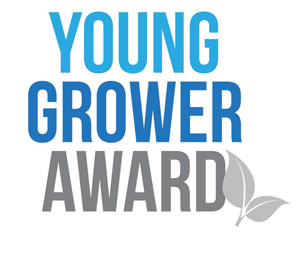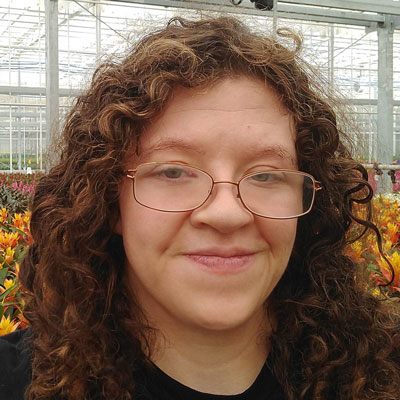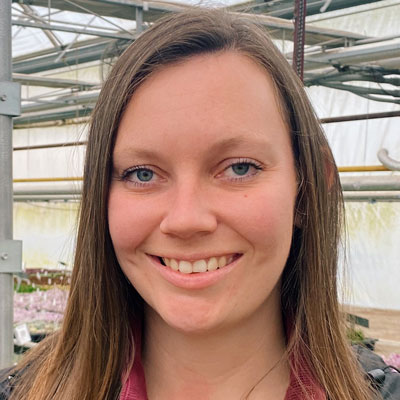6/1/2023
Ideas & Inspiration From Other Places
Jennifer Zurko

As many of you know if you’ve read my column, I didn’t come to Ball Publishing with a horticulture background. Like many people, I happily stumbled into this industry thanks to tenacity, the willingness to change and a little luck.
Although I’ve been in hort for 20 years now, I still use my previous professional experiences to guide me in my job with GrowerTalks. Being a newspaper reporter in the sports section gives you a thick skin, where you learn to think on your feet and check your fear at the door. It’s been very helpful when dealing with many aspects of writing for the hort industry. (And it helps when you need to insert an occasional sports reference every once in a while because you can’t find the words.)
I know this is the case with many of you, as well. So, this year, we decided to ask our three Young Grower Award finalists where they find ideas and inspiration outside of the horticulture industry. And their answers were interesting and on a wide range of the spectrum.
Laura Reese said she’s looked to the candy industry to help get ideas on how to market and present plants during different times of the year and for different holidays.
Matthew Tyson has used his experience as a collegiate athlete to help support and coach his production team. Like the game of football, growing plants is the coordination of many people working toward a common goal.
Elora Wannop gets inspiration to do better for the environment and her customers with her company’s sustainability initiatives, which includes following what other industries are doing by reducing plastic, and in what nature alone can bring when she herself has time to sit back and enjoy it.
Our panel of judges will choose the 2023 GrowerTalks/Ball Horticultural Company Young Grower Award winner based on their nomination applications, their essays and a telephone interview. We’d like to thank our esteemed judges for their time and support of this award. This year’s judges are:
Anna Ball—CEO & Chairman of the Board, Ball Horticultural Company, West Chicago, Illinois
Art Parkerson—Owner, Lancaster Farms, Suffolk, Virginia
Amy Morris—Vice President, N.G. Heimos Greenhouses, Millstadt, Illinois
Quinten Henning—2022 Young Grower Award Winner, Henning’s Farm & Greenhouses, DeMotte, Indiana

Laura Reese
Age: 28
Title: Grower
Operation: Green Circle Growers—Oberlin, Ohio
Q. Many find it useful to look outside of horticulture for ideas, inspiration and examples of new and novel business strategies. Where do you look for ideas? Give some examples.
One of the greatest hidden strengths of the horticultural industry is that many people realize their passion for horticulture later in their career—often bringing gained experience in other industries or fields of study. Although this lack of prior horticultural knowledge can make training personnel more time-consuming, it also provides opportunity to learn from other related or even unrelated industries. Observations that my coworkers and I have made based on our prior careers or from other industries, such as candy marketing, are a major source of ideas for Green Circle Growers.
For eight years, I studied, interned and worked in scientific research—first on agronomic crops, such as corn, wheat and sorghum, then in plant physiology. This has given me the ability to find and understand both crop recommendations and research papers from these fields. These have become reliable sources of ideas to implement in the greenhouse and improve our crop profitability.
For instance, tropical houseplants—information on their preferred lighting levels and fertilizer regimens may be limited, but they descended from field crops like pineapples and bananas, so agronomic studies and recommendations have provided an excellent source of information and crop growing strategies for these types of plants.
When I first began growing pineapples, I quickly discovered that horticultural information concerning them was extremely limited. Fortunately, agronomic information was readily available. I was able to use the recommendations and information on field-grown pineapples to determine our lighting, fertilization and temperature schemes for the pot-grown pineapple. This reduced our crop time from 45 weeks to 30 weeks, enabling us to increase the number of crops per year, which improved pineapple profitability. Using information from agronomic research, along with observations from our crop, I was able to further pinpoint the exact cause of scorching in the pineapple crop, which has allowed us to extend the window within when the plants can be transplanted and spaced from less than eight hours a day to 12 hours, which allowed a greater efficiency in operations surrounding the crop.
Botanical and ecological information and research have also been useful sources of ideas. For any new plant that I grow, I study information on its original habitat. The information on the climate and lighting conditions of the original habitat of houseplants like ferns has enabled us to emulate their optimal native habitat in the greenhouse as closely as possible (given that we’re located in Northern Ohio) and shorten crop times while improving their appearance.
While some of my primary contributions have been in improving the growth of the plants, many of my coworkers have been putting their experience in the auto manufacturing or healthcare product manufacturing industries to excellent use in improving the ways in which we produce and ship plants. One of the best contributions has been implementing first and last piece inspections. The name describes them perfectly: An employee checks the first batch of plants, makes note of any quality issues, and implements corrections as necessary. The effectiveness of those corrections is then checked in the last piece inspection when any remaining quality issues can be fixed the next time processes such as planting or shipping, occur. These sorts of inspections are more common in the auto and healthcare product industries, where quality issues have a far more life-changing impact than several leaning lilies going to market. However, first and last piece inspections have reduced the incidence of improperly planted plants and have improved our shipping quality as well.
Besides the collective experience and knowledge my coworkers and I have brought to Green Circle from prior careers, I’ve also found useful methods from other industries that market in a comparable manner to our own. Both houseplants and flowers, and candy and snack foods—rightly or wrongly—are considered non-essential purchases by many consumers. Most shoppers aren’t researching their decision prior to purchasing a houseplant—just as most don’t research their decision to buy a candy bar.
Like that last-minute grab for a candy bar, even many mums and bedding plants are impulse purchases from shoppers passing by the garden center on their way to buy air conditioners and light bulbs. Because of the similar nature of the impulse purchases, I’ve looked to the candy and snack food industries for ideas on how to market houseplants. One of the best ideas I’ve gotten is to increase marketing as much as possible aimed at every single holiday.
If you’ve ever walked down the candy aisle at your local grocery store, you’ve seen this idea in practice. Candy manufacturers change the color, the form, the packaging—even the candy itself—to theme it for different holidays throughout the year. Green floods the aisle around Saint Patrick’s Day, followed by a plethora of pastels and egg shapes at Easter. Pink returns for Mother’s Day followed by red, white and blue for much of the summer.
The horticulture industry has done well at marketing poinsettias for Christmas, mums for fall, Easter lilies prepped and timed for Easter, and, of course, the large orders for Mother’s Day and Valentine’s Day. But we sometimes fail to market our less-well-known plants to specific holidays and we neglect to market to as many holidays as we potentially could just by changing the presentation or selection of plants and colors. We can take the idea from the candy industry: any holiday is worth celebrating and, of course, the customer can celebrate it with our products!
I encouraged marketing to do this for the past few years and we’ve been successful in marketing red bromeliads for Chinese New Year (when red is a lucky color), pineapples with “Christmas in Hawaii”-themed stakes, and further seasonal mixes of anthuriums and bromeliads for non-traditional anthurium and bromeliad holidays such as Christmas and Halloween.
Looking outside of the horticultural industry can start inside our own organizations by tapping into the ideas and experiences that our employees may have gained in other industries to improve the quality of our plants. It can involve looking at research and information from other related fields, such as agronomic field crop production or the ecology of a habitat. Or we can even gain ideas just by being observant at the local grocery store. The crucial thing is to remember our next best idea can come from anywhere—or anyone.

Matthew Tyson
Age: 30
Title: Area Grower
Operation: Costa Farms—Miami, Florida
Q. Many find it useful to look outside of horticulture for ideas, inspiration and examples of new and novel business strategies. Where do you look for ideas? Give some examples.
Costa Farms is the world’s largest producer of indoor houseplants. As the Foliage Young Plant Grower, my responsibility is to ensure the successful growth and development of millions of high-quality liners. But at Costa Farms we believe in growing people first, then plants.
As a trained horticulturist, I’m very familiar with the methods of plant production, but managing an operation with more than 50 team members requires methods and skills that are outside of horticultural science. For my leadership framework, I look primarily to two sources of inspiration: my experience as a collegiate athlete and Lean Manufacturing principles.
For most of my life, I’ve played football. To the uninitiated, it may seem like a brutish sport that requires more brawn than brain, but I assure you that my experience in football was a highly valuable training ground for leadership in any organization. Football is a sport that requires the coordination of many people working toward a common goal, but with each player having very specific responsibilities that often require very different skills from the other players. To succeed, a team must develop a sound strategy, ensure players understand the objectives and how their contributions lead to success, prepare each player to perform their role at a high level, and motivate each team member to give their best effort. During a game, the coach cannot be on the field; players must be prepared to perform as planned and to adjust as needed. Leading a football team requires the development of management systems that allow the coaching staff to achieve all those results. This is very similar to the challenges of running a large operation.
At Costa Farms, we use the Costa Production System (CPS) to manage our operations. CPS is based on Lean Manufacturing principles. While initially developed for the automotive industry, Lean can be applied to any production process, including horticulture. I find the Lean philosophy is analogous to the way a football team should be managed. While most people know that Lean Manufacturing involves the reduction of waste, some may be unaware that the foundation of Lean is the development and empowerment of the workforce. In much the same way, a football team must prepare every player to meet a game’s challenges, expected and unexpected. Lean relies on empowering all workers to identify and solve problems in real time throughout the workday. Through “Servant Leadership,” we prepare and assist each team member to succeed.
Our success is limited by the competencies and efforts of our team. Applying my understanding of team building and player development through CPS, we’ve streamlined our production processes, reduced our impact on the environment, improved the quality of our products and enhanced the lives of our employees.
That last claim is possibly the most important, and certainly the most rewarding for me. To develop our team members, we do in-the-field training, classroom training and constant coaching. We teach effective communication, both individually and in meetings. We emphasize collaboration and Servant Leadership, and we create a sense of team and mutual accountability. From the testimonials of our workers, we’ve learned that we’re not only affecting the quality of our personnel at work, but many report they’re better prepared to handle challenges in their personal lives. This is extremely satisfying, as it enhances our sense of purpose.
The horticulture industry is experiencing many challenges that must be addressed to stay viable. These include rapidly increasing energy costs, wages, labor shortages and restrictions due to environmental concerns. The benefit of an empowered workforce is that it delegates problem solving to the team and allows leaders to dedicate more time to long-term projects and to look outside of horticulture for new ideas and strategies to stay competitive.
A recent example is the use of UV-C light in the propagation facility. Traditionally used in the medical field to sanitize and sterilize surfaces and equipment, I’ve adopted the technology into our IPM programs and procedures. By implementing the use of UV-C light to sanitize and sterilize our benches, trays and plants in the greenhouses, I’ve seen a reduction in disease, chemical use and labor, resulting in a healthier growing environment for plants and people.
Another novel solution I’ve helped implement is the use of organic cellulose polymer as a binding agent in our growing media. Organic cellulose polymer is used across a wide range of industrial applications, but is primarily utilized in industrial applications for its adhesive properties on porous surfaces to uphold strong uniformed bonds. By adding it to our media mixture, we’ve reduced our reliance on propagation paper. This reduced material and labor costs, improved water retention, and reduced fertilizer usage. These benefits all have positive environmental impact.
Our next challenge is the adoption of artificial intelligence (AI). We’ve long been interested in correlating environmental conditions to growth curves, and pests and diseases. Our results to date have been of little practical value, mostly because the amount of data that must be collected and analyzed makes it practically impossible. Our expectation is that by providing an AI system of real-time environmental data and images of crops over time, the system will learn to identify pests and diseases, as well as project growth and recommend treatment.
Although horticulture is a specialized industry, there are an abundance of lessons to be learned outside of its walls. My time as a football player in my formative years has given me the ability to lead a team with passion and compassion. Lessons learned by Lean Manufacturing has helped me streamline processes and reduce waste. The equipment from the tech industry has helped the development of agriculture tools and technologies. By creatively looking outside of horticulture for ideas and inspirations, I’ve been able to be part of the implementation of new technologies, enhancement of our production processes and create a positive work environment for our employees. With constant change occurring, it’s important to remain open to new ideas and strategies to stay competitive and reach personal long-term goals, as well as the company’s.

Elora Wannop
Age: 26
Title: Head Grower
Operation: Brookdale Treeland Nurseries—Niagara-on-the-Lake, Ontario, Canada
Q. Many find it useful to look outside of horticulture for ideas, inspiration and examples of new and novel business strategies. Where do you look for ideas? Give some examples.
I’m heading up to the cottage—a common Southern Ontario expression. I’m instantly flooded with nostalgic images of rustic lodges, crackling fires, lakeside docks, picturesque sunsets and afternoons filled with boat rides and water sports. This is where I find my peace, where I can disconnect from the day-to-day pressures and take time to reflect and reconnect with nature. This is where I find my inspiration.
The calmness and stillness of an early morning on the nursery before the irrigation kicks on and staff arrive for the day. The sun peeking up over the horizon. Our resident Mallard ducks waddling their way to the irrigation pond with their little ones in tow. The calming smell of lavender as you walk through the greenhouse. The vibrant array of colorful blooms and foliage. Like being at the cottage, these daily touchpoints help me stay grounded and connected with nature.
I’m reminded to slow down and be present. We live our lives at such a fast pace it becomes difficult to appreciate the subtleties found in nature. Many of us are in search of ways to reconnect with nature. It seems COVID has pushed us further into an indoor generation run by smartphones, Netflix and on-demand online shopping. As growers, we offer an opportunity to our customers to bridge that gap by incorporating the plants we grow to create a more natural living environment.
Popular trends in home design are bringing the exterior to the interior. We must take this into consideration in the products we produce. How can we provide easy solutions to new home growers that they can easily keep growing with little knowledge or experience? I look towards growing new and exciting tropical varieties that can be grown year-round inside our homes. We all know succulents are the first response we give to that friend who says they manage to kill every plant they own.
Brookdale Treeland Nurseries (BTN) Niagara grows over 1,200 different plant varieties, focusing on perennials. In that mix, we’ve been slowly increasing our tropical production to feed consumer demand. Speaking of feeding our consumers—we’ve been dabbling into vegetable and herb production! With rising food costs, the interest of growing your own food is also increasing. This is another wonderful way to reconnect with the earth, reaping the physical benefits of caring for and nurturing plants to produce a source of food, even if it’s as simple as an herb planter on an apartment windowsill.
From an early age, spending time up at the cottage surrounded by all the vast nature has taught me the importance of environmental preservation and stewardship. It has inspired me to be more mindful of our impact on this planet. One of BTN’s core values that I very much align with is “Bringing sustainability to everything we do—think long term and consider the impact of our actions on our earth. Reduce. Reuse. Recycle. Re-purpose and re-use whenever possible. Tread lightly and leave our environment equally, or healthier, than when we arrived.”
Sustainability has always been a passion of mine, and ultimately, what drove me to become a grower working with plants. Our industry still has a far way to go with our overall impact and ecological footprint, but I’m excited to be a part of the change we want to see in the world. I’m focused on moving away from pesticides and have incorporated a small-scale biopesticide program into our practices, with a focus in our propagation houses. Amblyseius swirskii, Phytoseiulus persimillis and Aphidius colemani are some of my top picks for protection against thrips, spider mites and aphids.
BTN has been progressing towards more sustainable initiatives. Our Heritage Perennials plastic pots are now produced with 95% post-consumer North American plastics. This inspires me to look at the next steps in reducing our plastic usage. Some areas I would like to focus on are looking at reducing our plastic labeling and packaging. Perhaps this means going the next step to put pressure on our suppliers to provide more sustainable and less-waste products and packaging. We see this across many other industries, not just horticulture. With the demand and help from other companies and consumers to hold us accountable to more sustainable initiatives, we can work together to advance these changes within our industry’s production cycle.
BTN has been using coconut coir as a media component and for weed inhibition for several years. Recent challenges in global supply chains and cost increases, as well as our own focus on sustainability, have pushed us to transition toward wood fiber as a media amendment. For weed prevention, we’ve implemented rice hulls as a top dressing that’s a food waste product from North America, which in turn reduces our overseas imports and herbicide usage.
The next generation of growers are no strangers to the importance of sustainability. They do, however, have a different view on sustainable work-life balance. Our industry has a history of overworking people, which makes it hard to attract the next generation of talent. Reading about the burnout in our industry really concerns me. I look to combat stress and burnout by creating a sustainable environment for mental health. I highly value my experience at the cottage in those pleasant moments and want to create more of that for myself and my team while on the nursery.
Understanding what motivates people and how to create rewarding environments is key to recruiting and retaining talent. I like to instill a sense of pride and quality to the crops we grow. By motivating our teams to take true ownership over their growing areas, quality really becomes personal and rewarding. The true reward is seeing beautifully even crops that have been irrigated and crafted to perfection, hitting the sales target, and heading out the door to our customer’s benches.
I’m optimistic that when our plants find their new homes in our customer’s gardens, they’ll create the same kind of serene escape that I get from enjoying my morning coffee out on the dock surrounded by the calm of the lake. GT
Find out who the winner is for our 19th Annual GrowerTalks/Ball Horticultural Company Young Grower Award at the Unplugged event during Cultivate’23 in Columbus, Ohio, being held at GasWerks from 8:00 to 10:00 p.m. on Monday, July 17.
